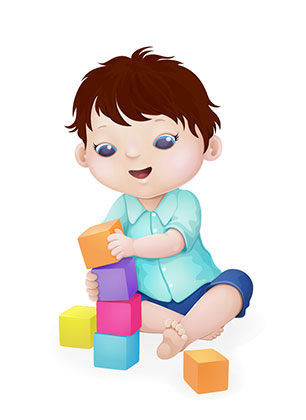
All toddlers have their own timetable, but you can watch for certain developments in your 2-year-old. Celebrate with your child as he reaches or nears these milestones.

Cognitive
-
Completes puzzles of three or four pieces (20)
-
Sorts objects by shape and color (20, 1)
-
Knows names of body parts (1)
-
Finds things hidden under two or more layers (1)
-
Finishes sentences in familiar books, songs, and nursery rhymes (1)
-
Follows two- and three-part commands (20)
-
Figures out simple mechanical toys (20)
Motor
-
Learns to kick a ball (20)
-
Jumps (20)
-
Walks up and down stairs with alternating feet, while holding on (20)
-
Pedals a tricycle (20)
-
Throws overhand (1)
-
May be able to stand on one leg (20)
-
Stacks blocks three or higher (20)
-
Unzips large zippers (20)
-
Turns handles; opens lids (20)
-
Uses a cup with one hand (20)
-
Begins to hold a crayon more like an adult‘s finger positioning (20)
-
Most are potty-trained by age 3 (17)
-
Runs with more coordination (20)
Communication
-
Likely knows 300 words by age 3 (20)
-
Speaks in sentences of three to four or more words (20, 13)
-
Usually speaks without repeating words or syllables (13)
-
Imitates most adult speech sounds but still mispronounces many words (20)
-
Probably chatters continuously (20)
-
Speaks clearly enough to be understood by strangers (20, 13)
-
Tells stories (20)
-
Follows many basic rules of grammar (20)
-
Uses the words “I,” “me,” “mine,” and “you,” though not always perfectly (20)
Ready for signs. Playing peekaboo, waving good-bye, and performing songs with gestures help prepare your baby for the idea of communicating with baby sign language. If you’d like to teach him some signs in the coming months, these actions are a good way to lay the groundwork.
Social
-
Pretend play mimics real-life emotions
-
Shows affection for familiar playmates (20)
-
Plays with other children (for example, chase), rather than just side-by-side play (1)
-
Employs basic turn-taking (20)
-
Understands the concept of possessives (mine, his, hers) (20)
-
Quick to show emotions, especially happiness and frustration (20)
-
Shows defiant behavior (doing things after being told not to) (1)
-
Dislikes major changes in routine (1)
-
Very responsive to people (watching them, imitating)(20,1)



